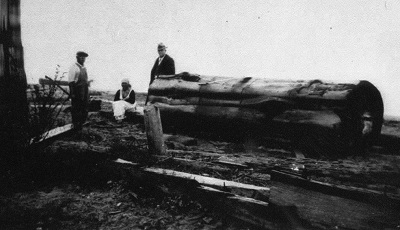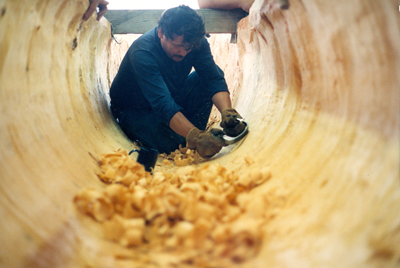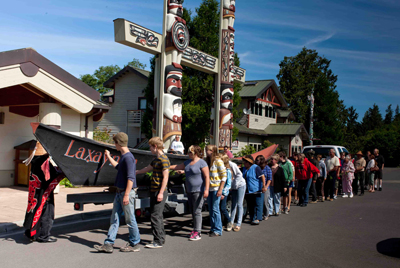
Old Clallam Indian at Jamestown making a canoe from a large cedar log.

Jamestown Tribal citizen Matt Adams carving the inside of the Laxaynem in 1993

In July 2011, the canoe Laxaynem was blessed by cleansing with cedar boughs, in preparation for the Canoe Journey to Swinomish. See more photos of canoe blessings
here.
Photo: Irv Mortensen
|
Old growth western red cedar trees ranging from 300 to 800 years old were used and determined the size of a canoe. In selecting a tree the importance of guarding spirit, purification rituals, suitable size, straight grain, no limbs on one side (to have fewer knots) and the ease of getting to the beach would determine if the tree could be used.
Specialists in canoe building made the larger canoes, while smaller dugouts and river canoes were easier to build and could be done by amateurs. Cedar trees were hollowed out first with stone tools, and later with metal implements. Today the chain saw is used in felling the tree, and for shaping and hollowing out the canoe.
Different styles of canoes were made for specific uses. The most common canoes in the Coast Salish area are Northern (Haida), Nootkan/West Coast, Coast Salish, Salish shovel-nosed river and Coast Salish racing. The SíKlallam used the Coast Salish and the Nootkan/West Coast styles. Many of the traditional methods and rituals described here are still carried out today by Salish Tribes.
The sizes ranged from large war and family-sized canoes capable of crossing the open waters of the Salish Sea, to smaller canoes handled by one person or for river use. The war canoes could be over 60 feet long, over eight feet wide and seven feet high at the bow. A freight canoe of good size had a carrying capacity of five tons.
The Jamestown SíKlallam Tribe has two canoes:
- Laxaynem, designed by, and carved with assistance
from Master Carver Duane Pasco, is a 37-foot traditionally carved and steamed canoe that was built in 1993. The canoe is named for the seventh son of Chief Ste-Tee-Thlum the Younger and his wife Tísus-khee-nakheen (Princess of Nanaimo).
- Eíow-itsa, a 34-foot cedar, fiberglass laminated canoe purchased in 2009, named for the little sister of the
seven brothers.
|

